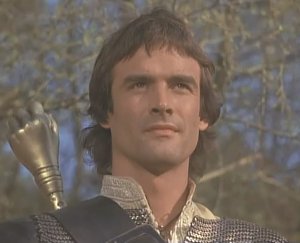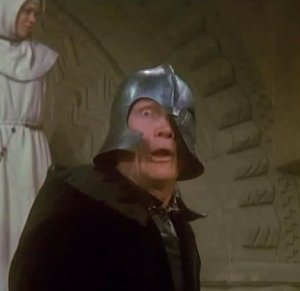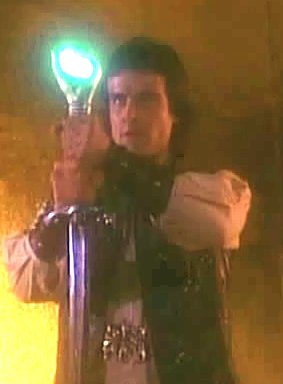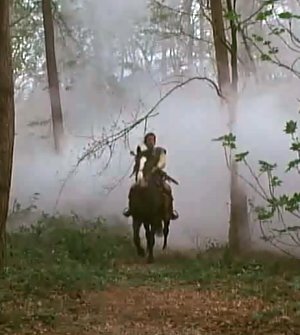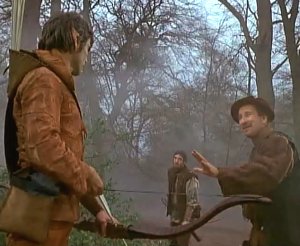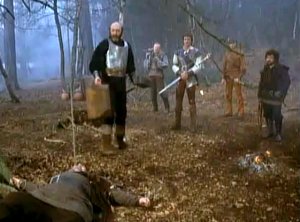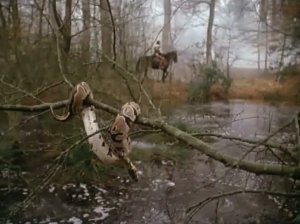Hawk the Slayer
Hawk The Slayer is a British film, made in 1980 by Terry Marcel and Harry Robertson. It is the story of Hawk, professional hero, swordsman and slayer, and also of Voltan, Hawk's evil brother.
Some say that Hawk is the definitive masterwork of the heroic fantasy film genre. Others go further, and say that Hawk is the definitive masterwork of all cinema. Controversially, some even say that Hawk is the finest piece of dramatic artwork ever produced by any human at any time throughout history. But all of these people insult the mighty Hawk with their faint praise. In fact, Hawk is the finest artwork in the entire Universe, and if thou sayest otherwise, Knave, then thou shalt taste cold steel!
Plot Synopsis[edit]
Hawk pioneered the quest-based story structure that would later be copied by lesser authors such as Shakespeare, Tolkien, Homer, Robert E. Howard and Jim Theils. Like all the quest-based stories that ripped it off, Hawk's plot can be divided into four sections:
Back Story[edit]
The back story is told through the innovative medium of flashbacks. At various points in the story, Hawk will say something like "I have good reason to suspect that Voltan can't be trusted". The camera will pan upwards slightly. Then there is a fade to idyllic countryside, where Hawk is chilling out with his newlywed wife Elaine.
Voltan (Jack Palance) is pissed that Hawk (John Terry) has married Elaine. He has been stalking Elaine for several years, has even spoken to her a couple of times, and once brushed against her boobs. Therefore, she is rightfully his. Anger and jealousy turn him to evil. (Remember - if it's in Hawk, it's not a cliche. Hawk invented this stuff. Other people copied it, making it cliched. Just like jokes about "It's built on an old Indian burial ground". It sounds cheesy when you hear it in The Shining, but you are wrong, because that's where it comes from.)
As a result of his psychotic hatred, Voltan tries to kill Hawk and has his face partly burned off by Elaine. This is why he wears a mask. All who see below the mask scream in horror! Voltan gets immediate revenge on Elaine by shooting her with a crossbow and she dies in Hawk's arms. At this point, relations betwen Hawk and Voltan sour slightly.
Fellowship of the Hawk[edit]
In the first major part of the story, Voltan kills his father. His brother Hawk arrives - too late to save the old man, but just in time to be granted The Sword of Mind. It glows and flies across a room into the hands of its owner. (George Lucas would later copy this idea for Star Wars.)
Voltan then goes off to rape and pillage a bit. He is evil, after all. His evil manifests all over the land, making everything really foggy and creating a lot of spider webs. While pillaging, Voltan kidnaps a nun and demands a ransom of 2000 gp ($5). This is a lot of money in the Dark Age, and because the Church has a policy of not negotiating with evil overlords, it cannot be paid. However, the Church does have a policy of kicking ass, so they send for Hawk. (This idea can be seen in every episode of 24, except the ones where they do negotiate with terrorists, i.e. most of them.)
Meanwhile, Hawk is riding around in the forest, searching for Voltan. He rescues a witch from being burned at the stake, and the audience sees that he is good. Unusually, the witch admits her witchiness, and luckily turns out not to be evil. She will periodically reappear in order to resolve plot holes. Next, Hawk rescues Ranulf, the messenger from the Church sent to find him. Ranulf is about to get a bandit ass-raping despite his 1337 crossbow skills, but Hawk steps in to save him.
The Fellowship of the Hawk begins to form. With the help of the witch, Hawk is teleported to the locations of three companions: a giant, an elf, and a dwarf. Each companion is engaged in some heroic fantasy activity that introduces them to tha audience, summing up their personality, motivation and personal background.
Crow: Hawk turns up just as Crow begins a shooting contest with two homosexuals. The audience learns that Crow is the last elf in the world, is really good at shooting, has Spock ears, and talks like a robot. (Orlando Bloom studied Crow's scenes repeatedly in preparation for Lord of the Rings, as the character of Legolas is transparently based on Crow. Tolkien used profits from "The Hobbit" to buy a cine projector for his Oxford home specifically so that he could watch Hawk every day until Lord of the Rings was completed. He saw it over 9000 times.)
Baldin: Hawk finds Baldin tied to a raft and being shot at by priests. Those wacky dwarves! In this scene, the audience learns that Baldin is really good at eating, drinking and telling bad jokes. He also comes from Ironforge. (Hawk has attracted criticism from dwarven rights activists for this stereotyped portrayal. Dwarf rights activist Ricky Gervais points out that not all dwarves are fat, drunk and unfunny, even though Ricky himself is frequently all three.)
Gort: Hawk arrives shortly after Gort has beaten up an angry mob. Gort is a giant, and therefore excellent at being stupid and tall. Gort is also very bad at acting: bad enough to appear in several Carry On films.
The Two Hawks[edit]
In the second part of the adventure, the Fellowship executes their plan to defeat Evil. They do this by stealing some gold from a hunchbacked slave trader, noting that "the ends justify the means if we can save the Mother Superior!" (This the first hint of the moral ambiguity of the "good" guys: Hawk is a very complex story where nothing is truly black or white.)
This operation gives them the opportunity to show off their special skills. Crow and Ranulf provide ranged DPS with dozens of arrows and crossbow bolts every second. Gort tanks. Baldin and Hawk provide melee DPS. Soon the slaves are freed and the hunchback lies on the forest floor, helpless. In a flash of sadism and bad acting, Gort hangs a mace from the tree above him, suspended by a rope which he places in the man's mouth. Inevitably, the hunchback opens his mouth to cry for mercy, and his head is crushed by the mace. Gort quips "Some people just can't keep their mouths shut." (This concept was later copied by James Bond, who often followed a grisly murder with an even worse one-liner.)
With the stolen gold as bait for Voltan, the trap is set. The Fellowship lie in wait for Voltan and his men. But Voltan doesn't appear. Instead, his useless adopted son Drogo turns up, without the kidnapped nun. The heroes refuse to hand over the gold until the nun is safe. Drogo is angry. "I am no messenger," he says. "But I do bring a message. The message of DEATH!"

This is followed by laughter a fight. Drogo's red shirts are mostly killed, and Drogo is mortally wounded. Two henchmen drag him back to Voltan, where he dies. Voltan is furious and starts killing his own people. This is because he is Evil (in case you had forgotten). Once again, Voltan swears vengeance on Hawk. (Play the "Hawk the Slayer" drinking game if you are an alcoholic or just desparate to win kudos from your dorky friends in the chess club. You must take a drink whenever a character says "DEATH". But beware that true Hawk fans will look down on you for watching Hawk in an intoxicated state. Watching Hawk is serious business.)
Return of the Hawk[edit]
That night, Voltan attacks the convent. Sister Judas, a well-meaning but stupid nun, drugs Gort and unlocks the door for Voltan. This allows Voltan to overpower the heroes, tie them up, and torture them. "Where is the gold?" he demands, after killing Sister Judas. ("Unfortunately, you will not live long enough to realise your mistake!")
Baldin claims to know where the gold is, but it turns out to be a clever ruse. He kicks Voltan in the face, causing intense pain (half of Voltan's face was burned off on account of him being Evil). Voltan stabs Baldin, then runs off to find a wizard, screaming in agony. His henchmen settle down for a long night of boozing, finally free of their emo overlord. (Like Hitler, Voltan hates everything even remotely pleasurable and does not allow drinking, smoking, singing or interpretative dance.)
Who can save Hawk now? Will the nun ever be rescued? Escape seems impossible... but wait...!
There is still a deus in the machina. The witch from scene 24 opens the convent door by magic, and then disables the guards with silly string. Thus saved, the heroes set off to raid Voltan's encampment. They do not rescue the nun or kill Voltan, but they do avenge Baldin by killing more henchmen and generally wrecking the place. (This pointless but destructive waste of time was later to inspire 4chan.)
The final scene takes place at the convent, as Voltan attempts to take revenge on Hawk. This is the first place in the film where the Sword of Mind's special powers are actually any use, because Hawk is able to call on the sword and (at long last) kill Voltan. And thus evil is defeated and the saga ends... or does it? (See "Sequels" below)
Soundtrack[edit]
Some might say that heroic fantasy should be accompanied by booming epic orchestral music of the Conan variety. These people fail to learn even the most basic lesson from the original and best heroic fantasy film.
Producer Harry Robertson knew that Hawk was a special film, a tale of two brothers locked in deadly combat to the end of time! Harry knew that only one type of music would have sufficient gravitas to carry it, and only one man was skilled enough to compose it. That music was disco, and that composer was Harry himself.
If you are from a parallel Earth where Youtube is a video site instead of a drainage pipe emporium, you can listen to the Hawk the Slayer soundtrack online. Like everything else about Hawk, the soundtrack is brilliance from beginning to end. Sure, Conan was good with its Basil Poledouris soundtrack, but imagine how much better it could have been with a bit of disco.
Hawk's Legacy[edit]

Not only did Hawk set the standard for heroic fantasy, it was also the genesis of an artistic tradition. Musicians have their "twelve bar blues", and writers have their own equivalent in the "generic quest story structure" popularised by Hawk. Leading Hawkologist Nick Lowe summarises the key properties of a derivative work.
Notable low-budget imitators of Hawk include:
Sponsorship and Product Placement[edit]
Hawk was sponsored by Ye Olde Militarie and Industrielle Complexe, the Dark Age arms manufacturer that was eventually closed down by Henry VIII, as it was (1) richer than him, and (2) had sold siege engines to the Pope. This was the medieval equivalent of selling a weaponized Ebola virus to Kim Jong Il.
YOMIC provided all of the crossbows, armor and magical swords used to make Hawk. The Sword of Mind is actually a modified version of YOMIC's "Sword/360" product, which proved to be notoriously faulty, most notably when Richard III's sword malfunctioned with a "red ring of oh, shit, I'm dead!" during the Battle of Bosworth Field, leading to his humiliating defeat. Ranulf's rapid-fire crossbow was an R&D prototype, later marketed as a YOMIC-3270. Again, it proved unpopular in battle. While YOMIC-3270 could fire twenty bolts in a couple of seconds, it took over an hour to reload. This was partly due to the limitations of Dark Age technology, but mostly due to the culture of incompetence at the giant defense contractor. The only things that YOMIC actually did well were product placement, bribing government officials and starting wars, a tradition continued by the descendants of YOMIC executives to this very day.
Sequels[edit]
Tragically, Hawk's producer Harry Robertson died in 1996. Without his vision, a new Hawk is impossible.
Making a sequel for Hawk would be like writing a sequel for the Bible. No improvement is possible, and anyone attempting an improvement would probably be crucified for their heresy against the mighty Hawk. The same goes for any remakes that anyone might think of doing. If you try, the true Hawk fans will be waiting like the Pharisees with a cross and some nails. So don't even try it. I'm looking at you, Nicholas Cage, in your shitty Wicker Man remake. I'm also looking at you, Tim Burton, with your pisspoor "version" of Planet of the Apes. Get lost, you mongs.
| Big Phish (2003) ♦ Edward 40-Hands (1990) ♦ Goldilocks and the Triumvirate of Bears (2013) ♦ Harry Potter & the Chamber of Semen (2002) ♦ Harry Potter & the Gobble Gobble Yikes (2005) ♦ Harry Potter & the Half Inch Prick (2009) ♦ Harry Potter & the Head Job Swallow (2010) ♦ Harry Potter & the Order of the Fuckhead (2007) ♦ Harry Potter & the Philosophers Stoned (1998) ♦ Harry Potter & the Prisoner of David Yikes (2004) ♦ Hawk the Slayer (1980) ♦ James and the Giant Peach (1996) ♦ Labyrinth (1986) ♦ The Lord of the Rings (trilogy 2001-2003) ♦ Mary Poppins (1964) ♦ Nazareth Park (2006) ♦ The NeverEnding Story (1984) ♦ Pan's Labyrinth (2006) ♦ Pirates of the Caribbean: At World's End (2007) ♦ Pirates of the Caribbean: The Curse of the Black Pearl (2003) ♦ Pirates of the Caribbean: Dead Man's Chest (2006) ♦ Snakes on a Plane (2006) ♦ The Wizard of Aus (1989) |
